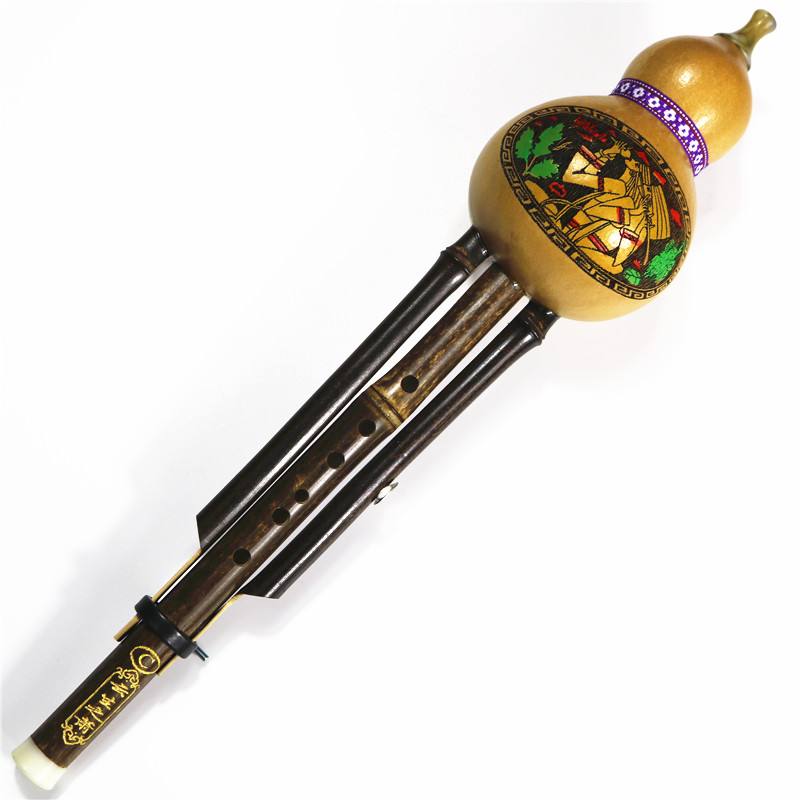The training skills of cucurbit silk circulation ventilation
The so-called cyclic ventilation refers to a breath method used by wind music when playing long-term uninterrupted phrases or music.

When playing the cucurbit flute, how to carry out the connection of circulating ventilation? When practicing cyclic ventilation, you should understand the entire breathing process and steps, and practice step by step. First, practice the treatment of residual air in the mouth, then practice breathing in through the nose, and finally practice the connection between the old and the new breath. When practicing, you must first master the process of oral cavity contraction and tongue base forwarding. Through training, you can enhance the control of residual qi and extend the time of residual qi delivery as much as possible.
The specific method is: first expand the oral cavity as much as possible (do not bulge the cheeks) to accommodate enough residual air, and then slowly and forcefully aspirate forward with the base of the tongue (at this time, the chest cavity and abdominal cavity do not exhale outward, and are in a relaxed state), The oral cavity is contracted, the lip muscles are tightened, and the residual air is controlled as much as possible, so that the flow rate and flow of the air can be effectively controlled, and the time for the residual air to be sent out is as long as possible. After mastering this stage, you can use your nose to inhale quickly at the same time (the process of inhaling air is the same as deep breathing). . That is, the remaining air delivery time = the inhalation time + the connection time. The entire process takes about one second to complete. Therefore, you need to experience it carefully, strengthen the training, and continuously learn from the training to gradually improve. At the beginning, first experience the movement of the mouth and the base of the tongue, and then use a thin bamboo tube or straw (the thin tube can extend the time for the remaining air to be sent out) to blow air in the water cup, observe the bubbles, and ask to achieve uninterrupted bubbles.
When the whole process is proficient, change to a slightly larger pipe and try again. After repeated training, after mastering it, you can try it out on the instrument. On the cucurbit flute, start with the overtone Mi, then practice in the middle range, and finally to all the Sound practice. Circulation ventilation training can generally be practiced with weak tones first, and then gradually practiced with strong tones until all the sounds can be freely circulated. What is the key to good circulation ventilation? The key to circulating ventilation is that the connection between the new air and the residual air must be soft and smooth, leaving no traces. The main process is: normal exhalation → expansion of the mouth to store residual air (the shape of the mouth is the same as the pinyin O sound, the base of the tongue is retracted, and the Adam’s apple is positioned downward) → the base of the tongue is inhaled = the rapid inhalation through the nose = the support point is moved down → the breath connection is raised → normal Exhale.
The key step is to move the support point of the diaphragm down to the step of lifting the breath. This step will affect whether the connection between the fresh air and the residual air has traces and whether it is smooth. When the base of the tongue sends air and inhales quickly and sinks the breath (same as deep breathing, the position of the support point is lowered, the pressure in the lower abdomen increases, and the waist expands), and then the breath is quickly lifted (through the pressure in the lower abdomen), pay attention to the process of breath lifting should be smooth and smooth, otherwise the breath It is easy to have a sense of interruption or sudden strength. After the breath is successfully connected, it will be transferred to normal exhalation. Usually, you need to take a breath when the breath is more than halfway through, and if one breath is not enough, you can take several breaths in a row to meet the breath of the music, but the music must be uninterrupted, and the music must not be suddenly strong or weak. situation should be consistent. It is not easy to master this point, you need to experience it repeatedly, find the feeling, and fix the found feeling through a lot of training to form a habit, so that the circulation can be used freely.
Through the practice of the above methods, you can gradually master the circulatory ventilation practice when playing the cucurbit flute, and make your playing level to a higher level.
 渝公网安备 50010702504639号
渝公网安备 50010702504639号